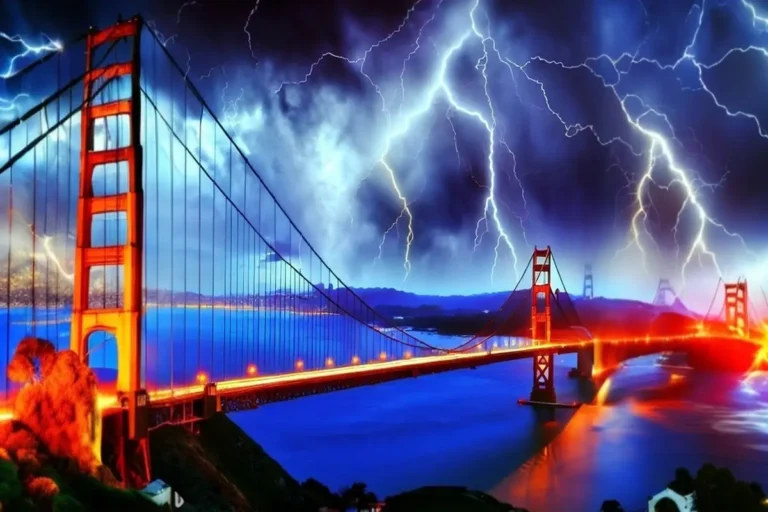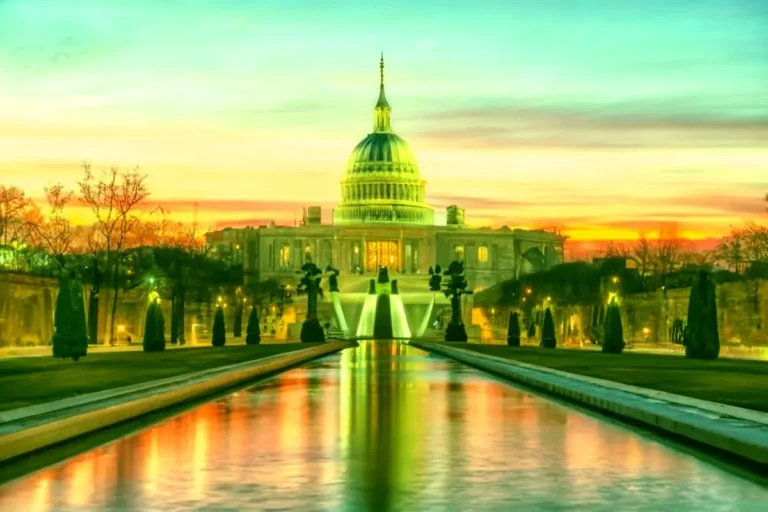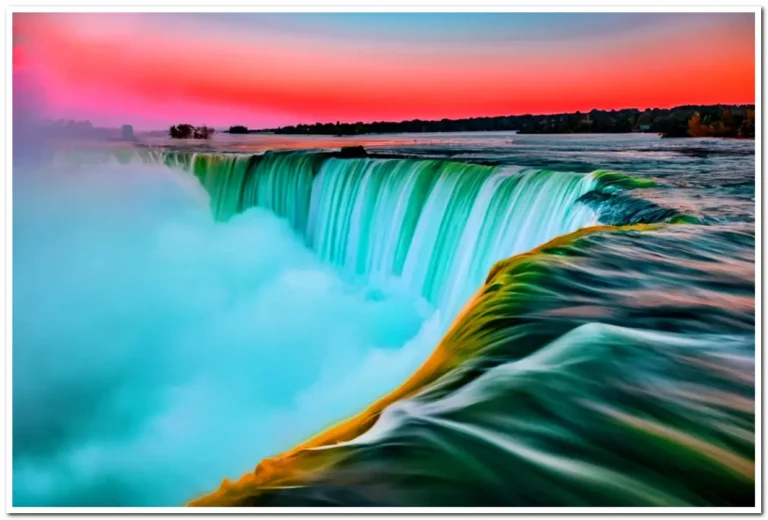Dive into Niagara Falls Facts
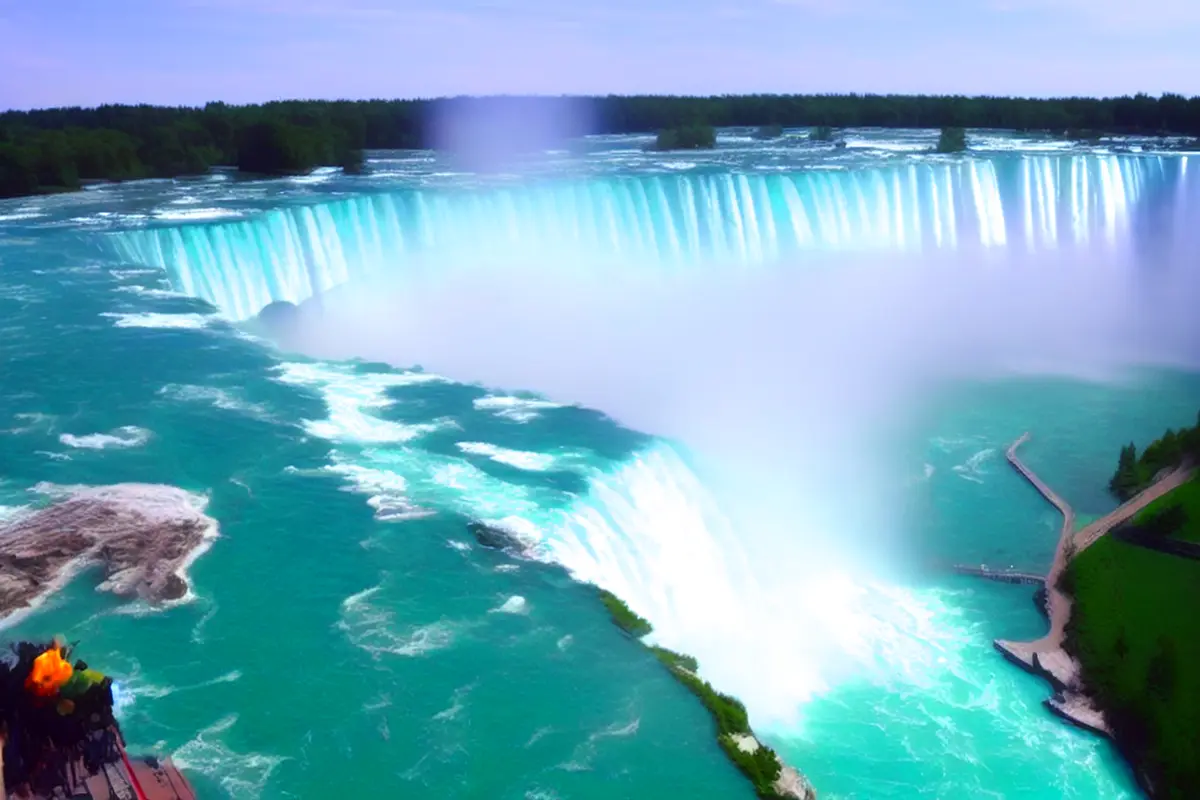
Table of Contents

Dive into Niagara Falls Facts… Everyone knows it is located on the border of the United States and Canada, and it is a breathtaking natural wonder that attracts millions of visitors each year.
Known for its stunning beauty and powerful cascades, the falls hold a rich history and numerous fascinating facts about the Niagara Falls North America.
In this article, we will explore some of the most Unforgettable facts about Niagara Falls, shedding light on its awe-inspiring nature and captivating allure.
The Niagara Falls are actually made up of 3 separate waterfalls
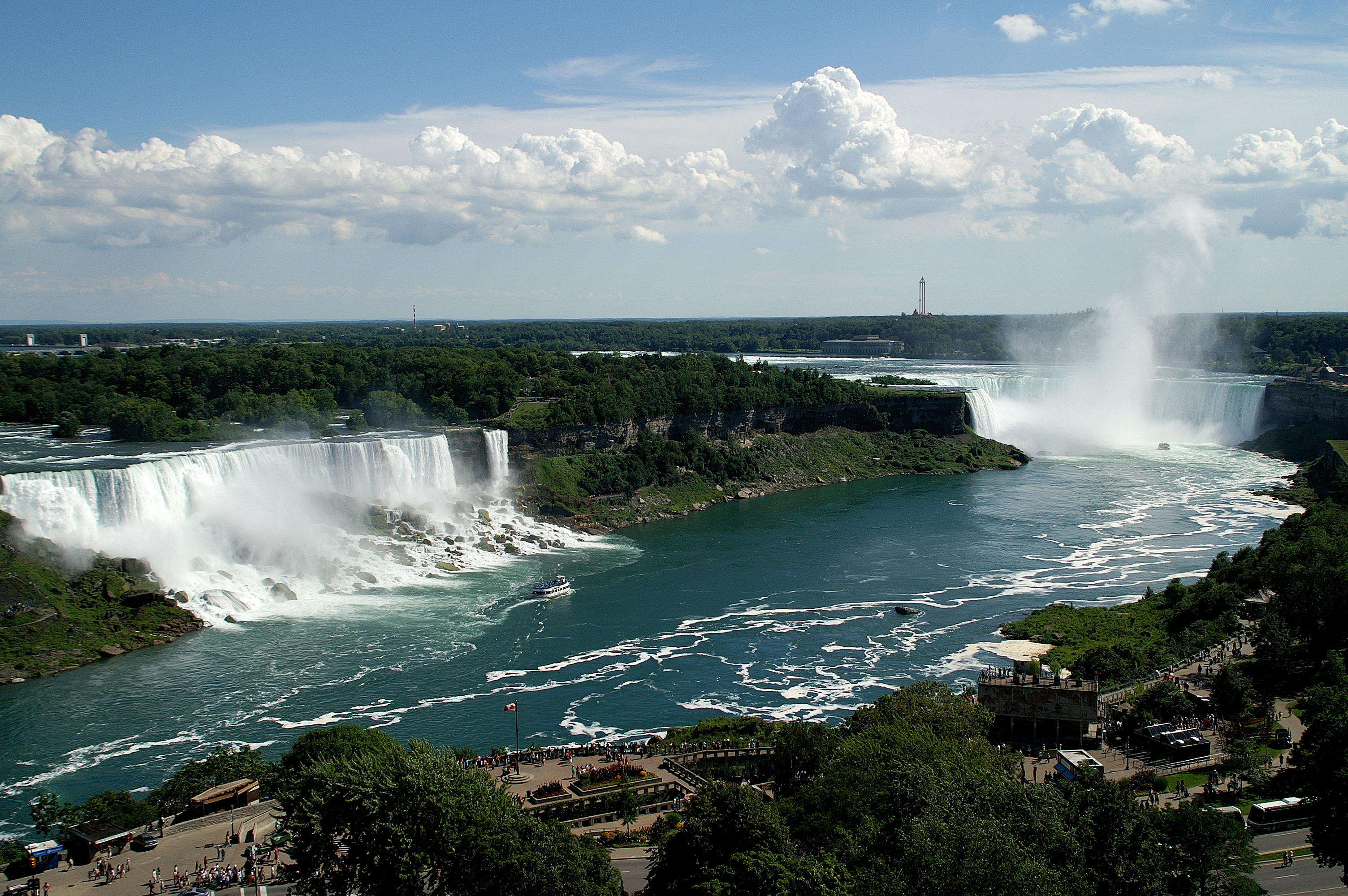
The Niagara Falls are often referred to in the singular, but they are actually a combination of 3 separate waterfalls:
American Falls
The American Falls are located entirely within the United States and form the waterfall’s southern end. They are 950 feet wide and range between 70-100 feet tall.
Horseshoe Falls
The Horseshoe Falls straddle the international border between the US and Canada.
They are aptly named for their horseshoe shape and are the largest and most powerful of the 3 falls.
The Horseshoe Falls are 2,700 feet wide and reach a maximum height of 188 feet.
Bridal Veil Falls
The smallest of the 3 is Bridal Veil Falls, located on the American side adjacent to the American Falls.
The bridal Veil is 56 feet wide and drops 180 feet into the gorge below.
10 Facts about Niagara Falls Illumination and Fireworks

1. Nighttime Magic:

When the sun sets over Niagara Falls, the mesmerizing spectacle of illumination and fireworks begins. The night sky comes alive with vibrant colors and bursts of light, creating a magical ambiance that captivates visitors.
2. Illumination History:
The tradition of illuminating Niagara Falls dates back to 1860 when the falls were first bathed in lights to celebrate a visit by the Prince of Wales. Today, powerful LED lights have replaced the old-fashioned bulbs, offering a more energy-efficient and dazzling display.
3. Eco-Friendly Lights:

In recent years, Niagara Falls transitioned to energy-efficient LED technology for its illumination, reducing its environmental impact. The LED lights produce a stunning array of colors, enhancing the beauty of the falls while being eco-conscious.
4. Illumination Colors:
The illumination colors of the falls change throughout the year to mark various occasions and celebrations. For example, red, white, and blue are displayed on the Fourth of July, and pink for Breast Cancer Awareness Month.

5. Fireworks Extravaganza:
The Niagara Falls fireworks show complements the illumination, adding a dynamic element to the nighttime experience. The pyrotechnic display is a spectacular blend of lights, colors, and music that leaves spectators in awe.
6. Seasonal Fireworks:

During peak tourist seasons and special holidays, such as New Year’s Eve and Canada Day, Niagara Falls hosts regular fireworks displays. The schedule may vary, so it’s best to check ahead of your visit.
7. Dual-Nation Show:
Niagara Falls Illumination and Fireworks are a collaborative effort between the United States and Canada. The display is enjoyed from both sides of the falls, offering fantastic viewing opportunities to all visitors.
8. Best Viewing Spots:

For an exceptional experience, head to Queen Victoria Park on the Canadian side or Prospect Point Park on the American side. These prime locations provide unobstructed views of the illuminations and fireworks.
9. Year-Round Show:
The illumination and fireworks show takes place year-round, weather permitting. Whether you visit in the vibrant summer or the serene winter, the nighttime magic of Niagara Falls awaits you.
10. Free for All:

There is no admission fee to witness the Niagara Falls Illumination and Fireworks show. It’s a remarkable and unforgettable experience that is accessible to everyone.
Revealing Fascinating Water Facts of Niagara Falls
More than 6 million cubic feet of water flow over the falls every minute
Experience the Dynamic Rush of Niagara Falls: Over 168,000 m3 (5.9 million cu ft) of Magnificent Water Descends the Falls Every Minute! This is perhaps one of the most mind-boggling facts about Niagara Falls.
Experience the Spectacle: Niagara Falls Unleashes a Torrent of 168 Million Liters in Just One Minute!
during peak daytime tourist hours
It’s a mind-boggling quantity that demonstrates the sheer magnitude of this natural wonder.
Picture a relentless flow, as if a colossal faucet were turned on, pouring forth an immense volume of water with incredible force and velocity.
This captivating spectacle showcases the unyielding power and majesty of Niagara Falls, leaving all who witness it in awe.
Imagine this remarkable fact: In just one minute, the amount of water released by Niagara Falls
To help visualize this massive amount, let’s compare it to:
- Olympic Swimming Pools(2.5 million liters):
- The volume of an Olympic-sized swimming pool is approximately 2,500,000 liters. Therefore, dividing Niagara Falls’ one-minute water output (168 million liters) by the volume of an Olympic-sized swimming pool gives us approximately 67 pools.
- Standard Bathtubs(80 liters):
- Considering a standard bathtub, which typically holds a volume of approximately 80 liters, let’s move forward with this common use case., dividing Niagara Falls’ one-minute water output (168 million liters) by the volume of a standard bathtub gives us approximately 2.1 billion bathtubs.
- Water Bottles (500ml):
- Assuming a water bottle has a volume of 500 milliliters, dividing Niagara Falls’ one-minute water output (168 million liters) by the volume of a water bottle gives us approximately 336 million water bottles.
- Tanker Trucks (30,000 liters):
- Assuming an average home swimming pool size of 40,000 liters, dividing Niagara Falls’ one-minute water output (168 million liters) by the volume of a home swimming pool gives us approximately 4,200 pools.
- Drinking Water Consumption (individual daily consumption):
- Assuming an average daily water intake of 3.7 liters per person, dividing Niagara Falls’ one-minute water output (168 million liters) by the individual daily consumption gives us approximately 45.4 million people.
- Swimming Pools (Home Pools):
- Assuming an average home swimming pool size of 40,000 liters, dividing Niagara Falls’ one-minute water output (168 million liters) by the volume of a home swimming pool gives us approximately 4,200 pools.
- Showers (5-minute showers):
- Assuming an average water flow rate of 9 liters per minute during a shower, dividing Niagara Falls’ one-minute water output (168 million liters) by the water flow rate per shower gives us over 18.6 million showers(1-minute shower). Dividing this by the duration of a 5-minute shower gives us approximately 3.7 million 5-minute showers.
- Watering Gardens (Garden Hose):
- Assuming an average garden hose flow rate of 10 liters per minute, dividing Niagara Falls’ one-minute water output (168 million liters) by the flow rate per minute gives us over 16.8 million minutes of continuous watering. Dividing this by 60 minutes gives us approximately 280,000 hours of continuous garden hose watering.
- Bottled Water (500ml):
- Similar to the previous comparison, dividing Niagara Falls’ one-minute water output (168 million liters) by the volume of a 500ml bottled water container gives us approximately 336 million bottles.
- Tea or Coffee Cups (250ml):
- Similar to the previous comparisons, dividing Niagara Falls’ one-minute water output (168 million liters) by the volume of a 250ml tea or coffee cup gives us approximately 672 million cups.
- Toilet Flushes (6-liter flush):
- Assuming an average water usage of 6 liters per flush, dividing Niagara Falls’ one-minute water output (168 million liters) by the water usage per flush gives us over 28 million toilet flushes.
- Laundry Loads (Top-loading Washing Machines):
- Assuming an average water usage of 150 liters per full load in a top-loading washing machine, dividing Niagara Falls’ one-minute water output (168 million liters) by the water usage per load gives us over 1.12 million laundry loads.
- Dishwashing Cycles (Standard Dishwashers):
- Assuming an average water usage of 20 liters per dishwasher cycle, dividing Niagara Falls’ one-minute water output (168 million liters) by the water usage per cycle gives us over 8.4 million dishwasher cycles.
- Glasses of Water (250ml):
- Similar to the previous comparisons, dividing Niagara Falls’ one-minute water output (168 million liters) by the volume of a 250ml glass gives us approximately 672 million glasses of water.
- Household Water Usage (average daily consumption):
- The calculation assumes an average daily household water consumption of 225 liters. Dividing Niagara Falls’ one-minute water output (168 million liters) by the average daily household water consumption gives us approximately 747,556 households.
These calculations provide a sense of scale and help visualize the immense volume of water flowing through Niagara Falls every minute, exceeding the total quantity of drinking water consumed by the entire Canadian population in an entire day, even if each individual consumes 3.7 liters of water. (The Canadian population is below 40 million, with an approximate current value of 38.7 million as of 2023.)
The sheer immense power and volume of the water going over the falls is unreal.
Photos and video can’t truly capture the sights and sounds of that massive quantity of water violently cascading down relentlessly, minute after minute. That is precisely why you should visit this miraculous place
The water flows from Lake Erie into Lake Ontario
The water that feeds the massive Niagara Falls originates from the Great Lakes, starting at Lake Superior and running through Lake Huron and Lake Erie before reaching Lake Ontario.
The Great Lakes contain about 20% of the Earth’s fresh surface water.
Lake Erie is the shallowest of the Great Lakes, with an average depth of only 62 feet.
This makes it easier for the lake to freeze over in the winter, contributing to the occasional ice jams that have impacted the flow of Niagara Falls.
The Niagara River that feeds the falls stretches about 58 kilometers from Lake Erie to Lake Ontario
The source of the tremendous amount of water that flows over Niagara Falls originates nearly 58 kilometers upstream.
The Niagara River starts at Lake Erie and winds northward until it reaches its dramatic plunge at the falls where it empties into Lake Ontario.
This entire stretch of river experiences fast-moving rapids as the water gets closer to its massive drop.
The gorge carved out by the river and falls is as an important conduit for trade and transportation between the upper and lower Great Lakes.
Unveiling the Power: Intriguing Facts about Niagara Falls’ Hydroelectricity
The Niagara Falls are a very powerful source of hydroelectric power
Harnessing the powerful falls for hydroelectric power has been happening since the 1800s.
Currently, there are 2 large hydroelectric plants, one on either side of the falls.
These plants have created reservoirs that actually reduce the water flow over the Niagara Falls during daytime hours.
- The Sir Adam Beck Generating Station in Ontario
- The Robert Moses Niagara Power Plant in New York
Niagara Falls inspired the development of hydroelectric power
The immense, perpetual power of the moving water passing over Niagara Falls inspired humans to think about harnessing that force.
The Adams Power Plant Transformer House located near the American Falls was the first facility to generate reliable, commercial electrical power from the falls in 1895. This pioneering development set the stage for hydroelectric power to spread across the globe.
Winter Wonders: Unveiling Fascinating Niagara Falls Facts in the Frosty Season
Niagara Falls has frozen over completely only once since records have been kept
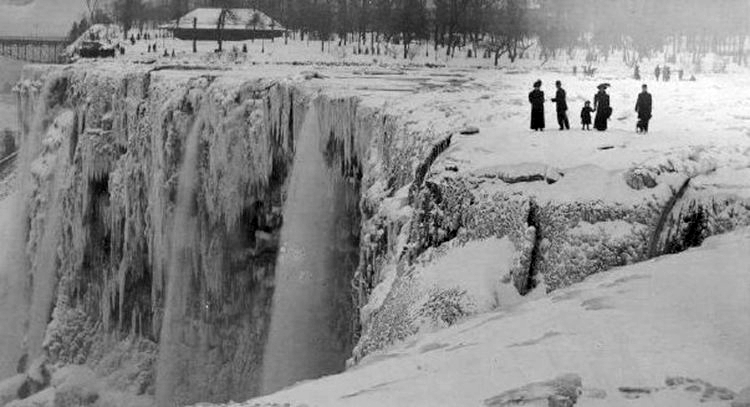
The raging waters of the Niagara Falls make them highly resistant to freezing over completely. However, an immense ice bridge did form over the entire falls in March of 1848.
Because of an immense ice jam in the Niagara River, the Niagara Falls actually stopped flowing for about 30-40 hours during the winter of 1848.
People were able to walk out and explore the riverbed completely dry under the frozen falls.
Since official record keeping of the falls began in the 1800s, this rare event has never happened again.
Smaller ice bridges block portions of the falls nearly every winter but never freeze the mighty Niagara Falls solid from bank to bank.
Niagara Falls generates spectacular ice formations each winter
Each winter, the mist and spray from the millions of gallons of water passing over the Niagara Falls freezes, leading to dazzling ice formations along the banks and cliffs.
Massive ice bridges form along sections of the falls.
Each one is uniquely shaped by the turbulent movement of the water underneath as it freezes.
When lit up at night, these natural ice sculptures are spectacular.
Unveiling the Geology: Fascinating Facts Related to Niagara Falls
Niagara Falls has moved back 7 miles(11 kilometers) over 12,500 years
One of the less appreciated facts about the Niagara Falls is just how much the falls has eroded and moved over the millennia.
Over the course of the Niagara Falls’ 12,500-year history, the relentless flow of water has eroded the riverbed and caused the falls to move back 7 miles upstream.
Scientists believe that when the Niagara Falls originally formed, they emptied into Lake Ontario from the location of current-day Lewiston, New York.
Relentless erosion continues as the water hammering down carves away at the rock below.
Years upon years of cascading water has slowly pushed the falls further south.
Geologists estimate that at the current rate of erosion, the next 50,000 years will bring the falls to Lake Erie, with erosion from that point forward causing them to disappear entirely.
Niagara Falls was formed by glaciers during the last Ice Age
The Niagara Falls owe their existence to the massive movement of glaciers during the last Ice Age, about 10,000 years ago.
As these enormous frozen rivers slowly advanced and retreated, they carved out the Niagara River basin from the surrounding limestone bedrock.
This glacial activity created the ledge, or cliff, that the Niagara River flows over today to create the world-famous waterfalls.
Scientists believe that initially, the falls were located several miles further down the river.
In the following list, you’ll discover additional geology-relevant facts about Niagara Falls:
- Niagara Falls was formed as a result of glacial activity during the last Ice Age, around 10,000 years ago. The retreating glaciers carved out the Niagara River, creating a path for the water to flow over the Niagara Escarpment.
- The Niagara Escarpment is a prominent geological formation that extends for hundreds of kilometers, from New York through Ontario. It is a steep cliff-like ridge created by erosion-resistant rock layers.
- The rock layers that make up the Niagara Escarpment are primarily composed of dolomite and limestone, which were deposited during the Silurian and Ordovician periods, around 420 to 450 million years ago.
- The dolomite and limestone formations of the Niagara Escarpment were originally deposited in a shallow sea, and over millions of years, they were compacted and hardened into solid rock.
- The presence of dolomite and limestone in the rock layers makes them highly susceptible to erosion by water, particularly from the forceful flow of the Niagara River over the falls.
- The erosion process at Niagara Falls is ongoing, as the powerful water flow erodes the softer rock layers at the base of the falls faster than the harder layers above. This continuous erosion has caused the falls to recede upstream over time.
- The retreat rate of Niagara Falls is estimated to be approximately one foot per year, though it can vary depending on factors such as water flow, ice jams, and human interventions.
- The American Falls and Bridal Veil Falls, located on the American side of Niagara Falls, are primarily composed of more resistant dolomite layers. In contrast, the Horseshoe Falls, located on the Canadian side, is mainly formed by less resistant layers of limestone.
- The force of the water flowing over Niagara Falls creates a tremendous amount of energy, leading to the constant erosion of the underlying rock layers and the shaping of the falls.
- The constant erosion of the Niagara River eventually causes the falls to “cut back” or retreat upstream, creating a steep gorge known as the Niagara Gorge. The gorge stretches for approximately 11 kilometers (7 miles) downstream from the falls.
- The Niagara Gorge exposes the underlying rock layers, providing a visible record of the geological history of the region. Visitors can see layers of dolomite and limestone, as well as evidence of past geological processes such as faulting and folding.
- The formation of the Niagara Gorge has also resulted in the formation of unique geological features, including whirlpools, rapids, and potholes, which further enhance the natural beauty of the area.
- The erosive power of Niagara Falls is not only a result of the water flow but also the presence of fine-grained sediments carried by the water. These sediments act as abrasives, further aiding in the erosion of the underlying rock layers.
- The geological history of Niagara Falls is intricately linked to the development of the Great Lakes. The falls serve as a natural drainage system, allowing water from Lake Erie to flow into Lake Ontario via the Niagara River.
- The formation and ongoing erosion of Niagara Falls have been studied by geologists and hydrologists for many years, contributing to our understanding of landscape evolution, erosion processes, and the interaction between water and rock.
These geology-relevant facts highlight the fascinating geological processes and features associated with Niagara Falls, showcasing the dynamic nature of this iconic natural wonder.
Daredevils have challenged Niagara Falls
Its towering height and violent rapids have long inspired daredevils and stunt artists to try to conquer the Niagara Falls.
Niagara Falls has a colorful history of daredevils trying to conquer it
The first person to survive a trip over the falls was teacher Annie Edson Taylor(63-year old), who bravely rode over the edge in a wooden barrel in 1901.
Since Taylor’s pioneering trip, 14 daredevils have intentionally gone over the falls.
Some have survived unscathed, others have died from impact injuries or drowning.
These thrill seekers have crossed the falls on tightropes, in barrels, kayaks, jet skis and even inside a giant inflated ball.
Niagara Falls played a strategic role in the War of 1812
Control of the Niagara Falls and the Niagara River was seen as strategically important during the War of 1812 between the United States and Great Britain.
The British built fortifications around the falls, such as Fort Drummond and Fort George.
Several key battles took place along the Niagara River, including the Battle of Queenston Heights and the Battle of Chippawa.
This demonstrated the vital tactical role that the Niagara Falls region held during the war.
Experience the Thrill of Niagara Falls with an Intense River Boat Tour
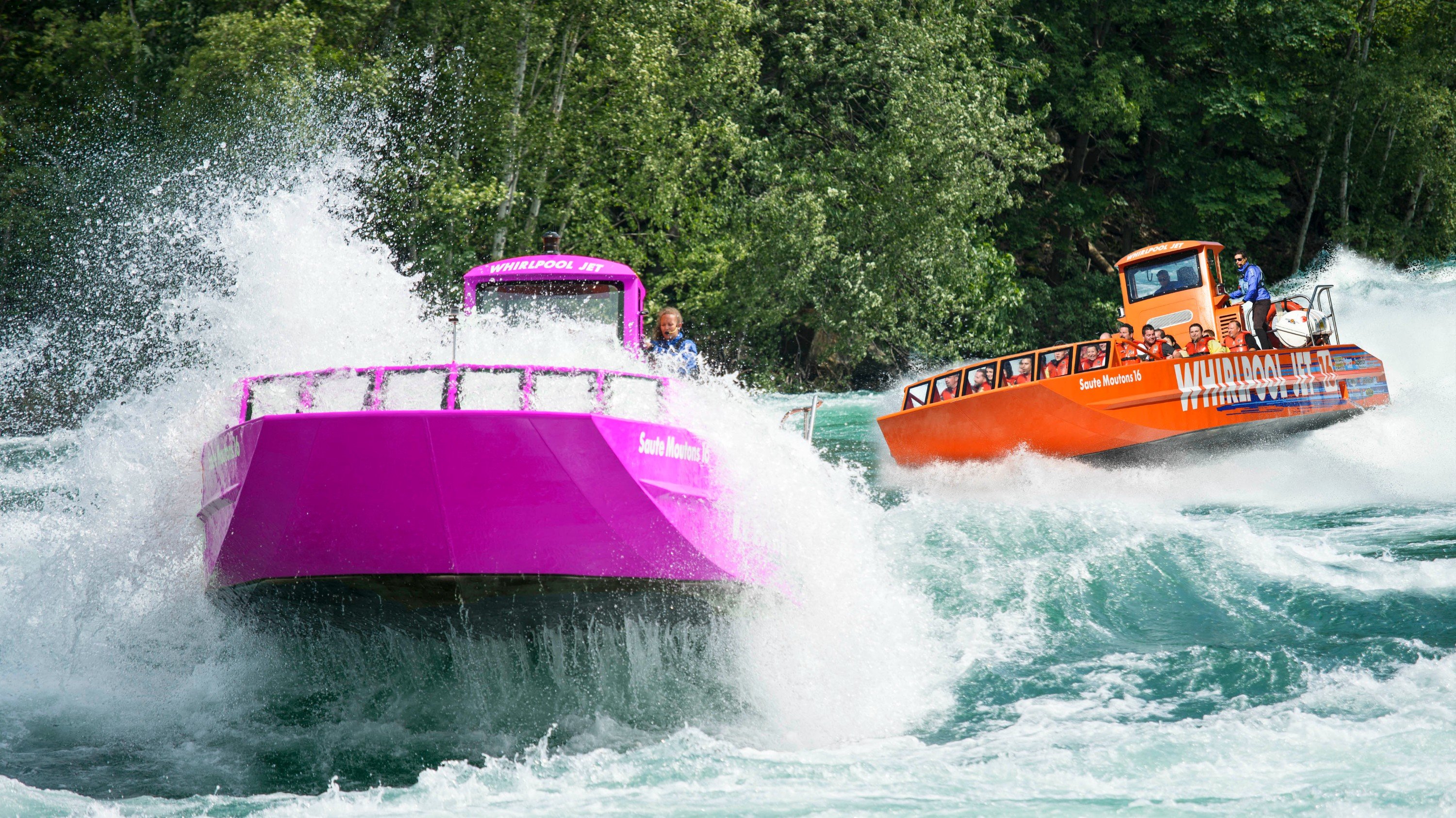
For adventurous tourists, the Niagara Falls has a unique boat tour option – the Niagara Falls Whirlpool Jet Boat Tours.
These exciting tours take passengers aboard 30 person jet boats for an up-close journey right into the powerful Class 5 rapids at the base of the falls.
The skilled captains navigate and spin the boats within just feet of the large, violent whirlpools. It’s a wet and thrilling way to experience the raw, intense rapids downstream of the Niagara Falls.
Niagara Falls Travel Facts
Over 14 million people visit Niagara Falls each year
The unique majesty and fame of Niagara Falls make it an immensely popular tourist destination, bringing in over 14 million visitors annually.
It’s estimated that over 12 million people visit the side of the falls located in Ontario, Canada each year.
Even with those huge crowds, there are ways to enjoy Niagara Falls without all the crowds if you know when and where to go.
Taking in the falls during the off-season or early morning offers a more relaxed experience.
Tourists can explore Niagara Falls by going behind the falls
Adventurous visitors can get a unique peek behind the immense curtain of cascading water at Niagara Falls.
Special tours take you through tunnels cut into the cliff behind the mighty Horseshoe Falls on the Canadian side.
Visitors can stand at an observation deck and look out through a special opening at the fury of the back side of the roaring falls.
It’s an unforgettable, wet way to gain a new appreciation for the true power of Niagara.
Niagara Falls attractions bring tourists no matter the season
The incredible beauty and allure of Niagara Falls make it a remarkable destination to visit any time of year.
Even in winter when icy mattes form, views of the partially frozen falls are spectacular.
Warmer months bring more tourists to soak in the sights and sounds from steamy observation decks.
Illumination of the falls at night adds even more majesty. The changing look of the falls ensures there’s always something magnificent to see.
Maid of the Mist boats have given tours below Niagara Falls for over 150 years
Niagara Falls visitors have been able to experience thrilling boat tours into the basin beneath the thundering falls for over a century and a half.
Maid of the Mist boats have been operating there since 1846, making them one of the oldest tourist attractions in North America.
Over time the boats have evolved from small steamboats to the present day’s large, diesel-powered vessels.
But their mission remains the same – giving tourists an unforgettable up-close encounter with the raging falls.
Niagara Falls has been attracting honeymooners for over 200 years

For newlyweds, it’s been a long-standing tradition to celebrate their marriage by visiting the grandeur and romance of Niagara Falls.
Honeymooning at Niagara Falls dates all the way back to the early 1800s.
In fact, the term “honeymoon” is believed to have originated from an old European tradition where newly married couples would drink mead (an alcoholic drink made with honey) for the first moon cycle after their wedding.
Additional Travel and Tourism Facts about Niagara Falls: Enhance Your Knowledge (Listed Below)
- The falls are easily accessible, with multiple airports nearby. The closest international airports are Buffalo Niagara International Airport in the United States and Toronto Pearson International Airport in Canada.
- Niagara Falls is a year-round destination, offering different experiences in each season. Visitors can witness the falls surrounded by vibrant foliage in the fall, frozen ice formations in the winter, blooming flowers in the spring, and lush greenery in the summer.
- There are several observation points and platforms that provide stunning views of the falls. The most famous ones include the American Falls Observation Tower, the Journey Behind the Falls attraction, and the Skylon Tower in Canada.
- The Maid of the Mist boat tour takes visitors on a thrilling journey to the base of the falls, providing an up-close and immersive experience. Passengers are given blue ponchos to protect them from the mist.
- The Hornblower Niagara Cruises in Canada is an alternative to the Maid of the Mist tour, offering a similar experience of getting close to the falls.
- The Cave of the Winds attraction on the American side allows visitors to descend a series of wooden stairs and walkways to experience the power of the falls up close. It provides an exhilarating experience with the Bridal Veil Falls cascading down nearby.
- The Niagara Falls State Park in New York is a popular starting point for exploring the falls. It offers various amenities, including hiking trails, picnic areas, and guided tours.
- Both the American and Canadian sides of Niagara Falls offer a wide range of accommodation options, including luxury hotels, budget-friendly motels, and cozy bed and breakfasts.
- The Niagara Falls Illumination Board illuminates the falls with colorful lights after sunset. The lights create a breathtaking display and can be seen from various viewpoints.
- Fireworks shows are regularly held over Niagara Falls during the summer months, providing a mesmerizing spectacle for visitors.
- Niagara Falls has a vibrant casino scene, with several casinos on both the American and Canadian sides. They offer gaming, entertainment, dining, and other amenities.
- The Niagara Falls Butterfly Conservatory is a popular attraction that houses over 2,000 tropical butterflies in a climate-controlled environment. Visitors can walk through lush gardens and observe these beautiful creatures up close.
- Niagara-on-the-Lake, a charming town located near the falls, is known for its historic sites, wineries, and theaters. It is a popular side trip destination for those visiting Niagara Falls.
- The Niagara Wine Region, located on both sides of the border, is renowned for its vineyards and wineries. Wine enthusiasts can enjoy tastings and tours, exploring the region’s diverse selection of wines.
- Niagara Falls is a family-friendly destination, with numerous attractions suitable for children, such as the Niagara SkyWheel, Clifton Hill entertainment district, and various water parks.
- The Niagara Parkway is a scenic road that runs along the Niagara River, offering picturesque views of the falls, gardens, and historic sites.
- The Niagara Falls International Marathon, held annually, allows participants to run a route that takes them across the international border, providing a unique experience.
- The Niagara Falls History Museum on the Canadian side showcases the history and heritage of the falls, including exhibits on daredevils, hydroelectric power, and the geological formation of the falls.
- Niagara Falls is a hub for outdoor activities such as hiking, biking, fishing, and golfing, with numerous parks, trails, and recreational areas in the surrounding region.
These travel and tourism-related facts highlight the diverse range of experiences and attractions available to visitors exploring Niagara Falls and its surrounding areas. - Niagara Falls has a vibrant casino scene, with several casinos located on both the American and Canadian sides.
There are two cities named Niagara Falls (one in Canada and one in the U.S.)
There are actually two separate cities, on opposite sides of the border, that bear the name Niagara Falls.
Niagara Falls, Ontario is located on the Canadian side of the falls. Approximately 88,000 people call this city home.
On the American side, Niagara Falls, New York has a population of around 50,000 residents. Niagara Falls is Undoubtedly Among the Top Attractions of the USA
Tourists often stay in one city and walk or drive across the border to view the falls from both countries.
Niagara Falls has its own weather station to monitor local conditions
Due to the huge influence that Niagara Falls has on the weather and climate in the immediate area, the falls has its own local weather station.
The Niagara Falls Weather Station has been recording temperature, rainfall, wind, humidity and other atmospheric measurements since 1946.
Weather scientists rely on this important data to understand microclimates created by the tremendous amount of mist and spray generated by the falls.
The station provides vital information about local weather not reflected in readings for the overall Niagara region.
Niagara Falls has inspired many famous works of art over the centuries
The incredible beauty and power of the falls has motivated many celebrated artists to try and capture its essence over the years through paintings, photographs, films, and more.
Famous works featuring Niagara Falls include paintings by American landscape artist Frederic Church, early black and white photos by William England, and IMAX movies by renowned filmmaker James Cameron.
The falls continue to serve as inspiration for new artistic endeavors today.
Niagara Falls has its own passport stamp for visitors
To commemorate their visit to the iconic Niagara Falls, tourists can get their own special passport stamps from the Niagara Parks Commission. The commission provides visitors with an opportunity to collect these special stamps at various locations within the Niagara Parks, including visitor centers and attractions.
Available at their gift shops on both the Canadian and American sides, these unique stamps are a cool way to mark your journey to see the falls.
Visitors from around the world love collecting these special stamps as a lasting reminder of seeing the mighty and magnificent Niagara Falls in person.
The stamps feature unique images of the falls.
The stamp is actually a souvenir that can be obtained at the Table Rock Welcome Centre or the Niagara Falls Visitor Centre.
It is not an official stamp that indicates entry or exit from either Canada or the US. To get an official passport stamp, tourists may have to cross the border by foot on the Rainbow Bridge and ask politely at the customs office.
However, there is no guarantee that they will get one, as some customs officers may refuse or discourage the request.
Niagara Falls once had a working incline railway called the Clifton Hill Incline Railway
In operation from 1875 to 1936, the Clifton Hill Incline Railway provided tourists a unique way to experience views of Niagara Falls.
This funicular railway traveled down a steep incline, allowing passengers to walk to scenic overlooks before riding the railway back up.
The railway consisted of two boarding stations connected by twin 90 meter long tracks with a gauge of only 2 feet.
The little carriages rode down and up on a simple pulley system powered by a stationary steam engine. It’s one of the many quirky ways people enjoyed the falls in the past.
12 interesting facts about Niagara Falls
- Tightrope walkers have also crossed the falls. Notable daredevils include Charles Blondin, who crossed on a tightrope in 1859, and Nik Wallenda, who crossed in 2012.
- Niagara Falls has been featured in numerous films and TV shows, including “Superman II,” “Pirates of the Caribbean: At World’s End,” and “The Office.”
- Niagara Falls has a rich history and has been an important location for Native American tribes, explorers, and settlers throughout the centuries.
- The name “Niagara” is derived from the Iroquoian word “Onguiaahra,” which means “thundering waters.”
- The first European explorer to witness Niagara Falls was Father Louis Hennepin, a French priest, in 1678.
- The flow of water over the falls can vary significantly depending on factors such as time of year, weather conditions, and hydroelectric power demands.
- Niagara Falls has inspired many artists, writers, and poets throughout history, including painters like Frederic Edwin Church and writers like Mark Twain.
- The first steel arch bridge over the Niagara River, known as the Rainbow Bridge, was completed in 1941 and connects the United States and Canada.
- The Niagara Falls State Park in New York is the oldest state park in the United States, established in 1885.
- The Niagara Gorge, located downstream from the falls, offers opportunities for hiking, rock climbing, and other outdoor activities.
- The first person to go over the falls in a barrel and die was Bobby Leach in 1911. He survived the fall but later succumbed to injuries from the impact.
- Niagara Falls has been a significant source of inspiration for the creation of various works of art, including songs, poems, and literature.
14 lesser-known facts about Niagara Falls:
- In 1969, the American side of Niagara Falls was temporarily turned off. This was done to study the geological formations and remove accumulated rock debris.
- The first recorded person to survive going over Niagara Falls in a barrel was a female schoolteacher named Annie Taylor. However, it is estimated that around 15 individuals have attempted the feat since then, with varying degrees of success.
- In 1912, a man named George Stathakis went over the falls in a steel barrel with his pet turtle. Both he and the turtle survived the plunge.
- Niagara Falls has attracted tightrope walkers from around the world. One of the most daring performances was by Maria Spelterini, an Italian tightrope walker who crossed the gorge multiple times, including once while wearing peach baskets on her feet.
- During World War II, the lights illuminating Niagara Falls were turned off to conserve energy and to avoid guiding enemy aircraft towards industrial targets.
- A section of Niagara Falls, called the “Terrapin Rocks,” eroded over time and completely disappeared by the late 1950s.
- Niagara Falls has its own hydroelectric power plants, which collectively generate a significant amount of electricity for both the United States and Canada. The Robert Moses Niagara Power Plant, located in Lewiston, New York, is one such plant.
- The Maid of the Mist boat tours, which take visitors to the base of the falls, were initially powered by steam. Today, the boats are powered by eco-friendly electric motors.
- Over the years, a few people have attempted to swim across the Niagara River or go over the falls without any protective devices. These attempts are highly dangerous and illegal in both the United States and Canada.
- The first person to go over Niagara Falls in a barrel and survive with no injuries was a seven-year-old boy named Roger Woodward. He accidentally fell into the river above the falls in 1960 and was swept over Horseshoe Falls wearing only a life jacket.
- The American Falls used to be the site of a popular tourist attraction called the “Cave of the Winds.” Visitors would descend a series of wooden stairs to a platform near the base of the falls. However, due to erosion, the attraction was dismantled in 1954 and relocated closer to the Bridal Veil Falls.
- The Niagara Falls region has a history of being a significant smuggling route during Prohibition in the United States. Smugglers would transport alcohol across the Niagara River, taking advantage of the international border.
- The area around Niagara Falls is known for its wine production. The Niagara Wine Trail, located on the American side, offers visitors the opportunity to explore various wineries and vineyards.
- In 1995, Canadian daredevil Kirk Jones survived going over Horseshoe Falls without any protective devices. He suffered only minor injuries and became the first person to survive the plunge without a barrel or similar contraption.
These lesser-known facts offer a glimpse into the fascinating history and unique occurrences surrounding Niagara Falls.
Discover Fascinating Facts about the Animals, Plants, Wildlife, and Environment Surrounding Niagara Falls
Ecosystem and Wildlife
The Niagara Falls region is not only renowned for its natural beauty but also for its rich ecosystem. The falls and the surrounding area provide a habitat for a diverse range of plant and animal species. The Niagara River is home to various fish species, including Lake Sturgeon, Lake Trout, and Bass. The area also attracts numerous bird species, making it a paradise for birdwatchers and nature lovers.
Environmental Conservation
Preserving the natural beauty and ecological integrity of the Niagara Falls is of utmost importance. Efforts have been made to protect and conserve the falls and its surrounding environment. Both the United States and Canada have implemented measures to regulate water flow and maintain the falls’ natural balance. Environmental initiatives aim to safeguard the area’s biodiversity and ensure its sustainability for future generations.
Animals(Fauna):
- The Niagara River and its surrounding areas are home to a diverse range of animal species, including mammals, birds, fish, and reptiles.
- Several species of fish can be found in the Niagara River, including bass, trout, salmon, and sturgeon. The river serves as an important spawning ground for various fish species.
- The Niagara Gorge provides a habitat for several bird species, including bald eagles, peregrine falcons, great blue herons, and various migratory birds.
- White-tailed deer, raccoons, skunks, and squirrels are among the mammals commonly spotted in the wooded areas surrounding Niagara Falls.
- The Niagara River is also home to a variety of amphibians and reptiles, including turtles, frogs, and snakes.
- One of the iconic animals associated with Niagara Falls is the beaver. These industrious creatures can be found in the surrounding rivers and streams, building dams and lodges.
- The American black bear is native to the region around Niagara Falls, although sightings are relatively rare due to their elusive nature.
- The waters of the Niagara River and its tributaries support a variety of aquatic life, including freshwater mussels, crayfish, and various insect species.
- Butterflies are abundant in the region, with the Niagara Parks Butterfly Conservatory providing a habitat for numerous species.
- Bats, including the little brown bat and the big brown bat, can be found in the area. They play an essential role in controlling insect populations.
These facts highlight the diverse range of animals, flora, and fauna that contribute to the natural ecosystem surrounding Niagara Falls. Exploring the region provides opportunities to observe and appreciate the rich biodiversity that thrives in this unique environment.
Plants(Flora)
- The region around Niagara Falls features a mix of deciduous and coniferous forests, showcasing a diverse array of trees and plant life.
- Trees such as maple, oak, beech, birch, and hemlock can be found in the forests surrounding Niagara Falls.
- The Niagara Glen Nature Reserve, located along the Niagara Gorge, is known for its unique plant life, including rare ferns, mosses, and wildflowers.
- The spray from Niagara Falls provides a moist environment that supports the growth of lush vegetation, including ferns, mosses, and various plant species adapted to the damp conditions.
- The Niagara Parks Botanical Gardens and School of Horticulture, located near Niagara Falls, feature beautifully landscaped gardens with a wide variety of plant species from around the world.
15 Historical facts about Niagara Falls:
- Indigenous peoples, including the Haudenosaunee (Iroquois) and Ojibwe, have inhabited the region around Niagara Falls for thousands of years.
- The first recorded European explorer to witness Niagara Falls was French priest Father Louis Hennepin, who wrote about the falls in his book published in 1697.
- During the 18th century, the British and French vied for control of the Niagara region due to its strategic importance in the fur trade. The area changed hands several times during conflicts such as the French and Indian War and the American Revolutionary War.
- In 1812, during the War of 1812 between the United States and Britain, the Battle of Queenston Heights was fought near Niagara Falls. The British, aided by Indigenous allies, successfully defended against an American invasion.
- The first bridge over the Niagara River, known as the “Upper Steel Arch Bridge” or “Honeymoon Bridge,” was completed in 1898. Unfortunately, it collapsed in 1938 due to ice accumulation.
- The Niagara Falls hydroelectric power plants were instrumental in the growth of the electrical power industry in North America. The first hydroelectric power plant at Niagara Falls, the Edward Dean Adams Power Plant, began operations in 1895.
- The Great Depression in the 1930s prompted construction projects to stimulate the economy, including the creation of the Niagara Falls State Park, the oldest state park in the United States, established in 1885.
- In 1969, an engineering feat known as the “Niagara River Control Works” was completed. It involved the construction of a cofferdam to temporarily divert the flow of the American Falls to study erosion and remove accumulated rock debris.
- Niagara Falls has attracted daredevils who attempted various stunts and challenges. Some notable daredevils include Annie Edson Taylor, who went over the falls in a barrel in 1901, and Nik Wallenda, who crossed the falls on a tightrope in 2012.
- The Niagara Treaty of 1950 between the United States and Canada established the Niagara River as the boundary between the two countries, ensuring shared use and preservation of the natural resource.
- In 2005, the governments of the United States and Canada signed the Niagara River Greenway Plan, a cooperative effort to preserve and enhance the natural, cultural, and recreational resources along the Niagara River.
- Niagara Falls has been a popular tourist destination since the 19th century. Early visitors arrived by steamboat, and the area developed into a thriving tourism industry, with hotels, attractions, and entertainment venues.
- The tourism industry around Niagara Falls has continued to grow, with the region attracting millions of visitors each year from around the world. Visitors can enjoy boat tours, observation decks, museums, and other attractions.
- The surrounding cities, Niagara Falls, New York, and Niagara Falls, Ontario, have evolved to cater to tourism, offering a range of accommodations, dining options, and entertainment venues.
- In recent years, there have been efforts to revitalize the areas around Niagara Falls, including the development of new attractions, improvements to infrastructure, and the promotion of sustainable tourism practices.
These historical facts provide a glimpse into the significant events, developments, and transformations that have shaped the history of Niagara Falls and its surrounding regions.
Niagara falls photos










Final Flourish on Niagara Falls Facts
This massive collection of thundering waterfalls straddling the US-Canada border offers countless fascinating facts and stories.
From its breathtaking beauty and sheer power to its rich history and daring adventures, Niagara Falls has captivated people for centuries.
As this travel blog post highlights, the immense volume of water cascading over the falls is almost impossible to fathom. Nearly 6 million cubic feet rush over the edge every minute!
The falls have inspired innovations like hydroelectric power and drawn daredevils seeking fame. Their scale and beauty have attracted tourists, artists, honeymooners and more for over 200 years.
Yet there is still more to discover about Niagara Falls. Lesser-known facts reveal quirky tidbits and close calls from its storied past.
The area is also home to an abundance of wildlife and serves as an important ecosystem. Through conservation efforts, the majesty and natural wonder of Niagara Falls will hopefully endure for many generations to come.
A visit to Niagara Falls is a truly unforgettable experience. Getting up close to the thundering waters by boat or behind the falls allows you to feel their immense power.
There are so many ways to enjoy the fall’s beauty and adventure. Walking along the Niagara Gorge reveals the geologic forces that shaped the area over thousands of years.
The rich history and culture of neighboring cities and towns beckons visitors to explore further. However you choose to experience it, Niagara Falls offers an incredible travel destination.

